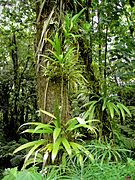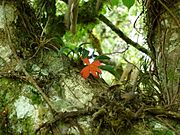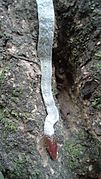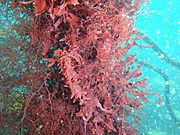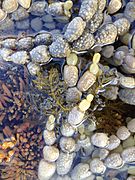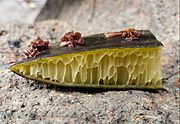Epiphyte facts for kids
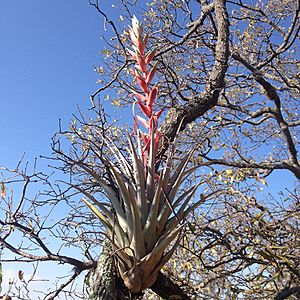
An epiphyte (say "EP-ih-fite") is a plant or plant-like living thing that grows on the surface of another plant. It gets its water and food from the air, rain, or from bits of dead leaves and other things that gather around it. The plants they grow on are called "phorophytes."
Epiphytes are important parts of their ecosystems. They add to the variety of life and the total amount of living material. They also provide food for many animals. You'll often find more epiphytes on the older parts of a plant.
Epiphytes are different from parasites. While they grow on other plants for support, they don't usually harm their host plant. If an organism grows on another organism that isn't a plant, it's called an epibiont.
You can find epiphytes in cooler areas, like many mosses, liverworts, lichens, and algae. They are also common in tropical places, such as many ferns, cacti, orchids, and bromeliads. Because they don't need much water or soil, many epiphyte species make great houseplants. They also create homes for other living things like animals, fungi, and bacteria.
The word epiphytic comes from Greek words: "epi-" means 'upon' and "phyton" means 'plant'. Epiphytic plants are sometimes called "air plants" because they don't root in soil. However, this name isn't always perfect, as some algae are epiphytes on other water plants.
Contents
Plants That Grow on Other Plants
The most well-known epiphytic plants include mosses, orchids, and bromeliads. A famous bromeliad is Spanish moss (from the Tillandsia group). But epiphytes can be found in almost every major plant group.
Most terrestrial (land-based) epiphyte species, about 24,000, are flowering plants. The next largest group is ferns, with about 2,800 species. About one-third of all fern species are epiphytes!
Large groups of epiphytes are most common in moist tropical forests. However, mosses and lichens grow as epiphytes in almost all types of environments. In Europe, there are no plants that only grow as epiphytes using roots. But many mosses and lichens grow on trees in damp areas. The common polypody fern also grows on tree branches. Sometimes, grass or small bushes might even grow in soil that collects in tree holes.
- Terrestrial epiphytes
-
Clinging root of an orchid
Types of Epiphytes
Epiphytes can be divided into two main types: holo-epiphytes and hemi-epiphytes.
- A holo-epiphyte is a plant that spends its entire life cycle without touching the ground. Orchids are a common example of holo-epiphytes.
- A hemi-epiphyte is a plant that starts its life without touching the ground. But later, its roots grow down and connect with the soil. Strangler Figs are a good example of hemi-epiphytes.
How Epiphytes Get Food and Water
Since epiphytes are not connected to the soil, they must get their nutrients from other places. They collect water from fog, dew, rain, and mist. They also get food from nutrients released by decaying plants or from nitrogen in the air.
Epiphytic plants that live high in the tree canopy have an advantage. They get more sunlight than plants on the ground. Also, there might be fewer plant-eating animals high up. Epiphytic plants are also important for certain animals, like some types of frogs and insects, which can live in the water collected by the plants.
Epiphytes can greatly affect the environment around their host plant. They hold water in the tree canopy, which means less water reaches the soil below. Some non-vascular epiphytes, like lichens and mosses, are very good at soaking up water quickly. Epiphytes create a cooler and more moist environment in the host plant's canopy. This can help the host plant lose less water through its leaves.
How Epiphytes Save Water
Many epiphytes use a special way to save water called CAM metabolism. This is very helpful for plants that live in the air. For example, about half of all epiphytic orchids are thought to use this method. Other epiphyte families that use CAM metabolism include Bromeliaceae (like Aechmea and Tillandsia), Cactaceae (like Rhipsalis and Epiphyllum), and Apocynaceae (like Hoya and Dischidia).
Ocean Epiphytes
Epiphytes in the ocean are different from those on land. Marine epiphytes are types of algae, bacteria, fungi, sponges, and other creatures that grow on the surface of ocean plants. They often grow on seagrasses or seaweeds.
Where marine epiphytes settle depends on things like light, temperature, currents, and available food. Algae are the most common group of epiphytes in the ocean. These photosynthetic epiphytes (meaning they make their own food using sunlight) are responsible for a large amount of the food production in their ecosystems. They provide food for many different animals, such as snails and nudibranchs.
The types and amounts of epiphytes can show changes in the environment. For example, a recent increase in epiphytes has been linked to too much nitrogen from farm runoff and storm water. A lot of epiphytes can be harmful to the plants they grow on, especially seagrasses. This is because too many epiphytes can block sunlight or nutrients from reaching the host plant. Marine epiphytes are known to grow very quickly.
- Marine epiphytes
-
Cross-section of a Durvillaea antarctica frond, showing Pyrophyllon subtumens growing on the outer surface
See also
 In Spanish: Planta epifita para niños
In Spanish: Planta epifita para niños


